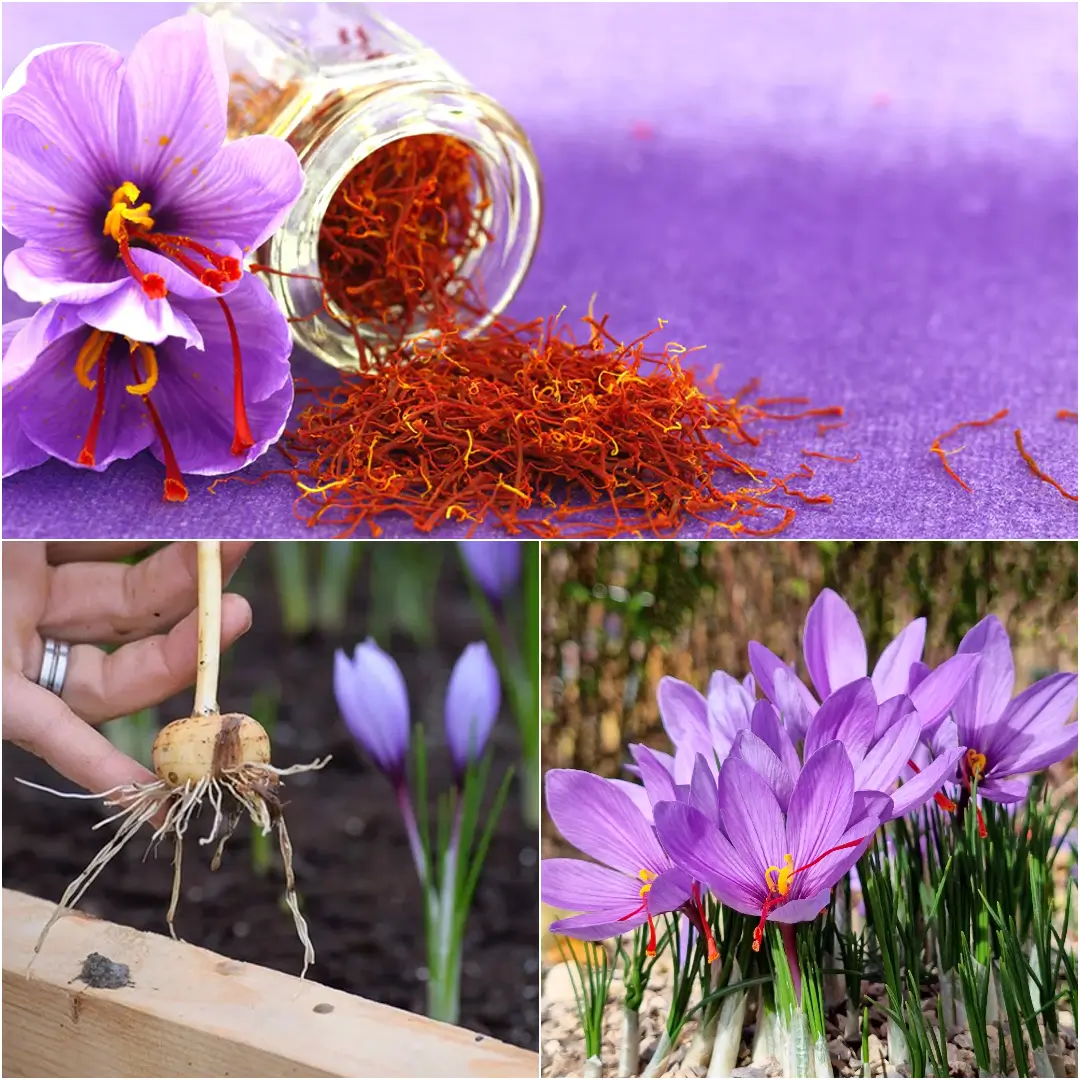When it comes to growing one of the most valuable spices in the world, saffron holds a special place. Known for its rich color, distinct aroma, and a price tag that can make it seem like gold dust, saffron is a spice worth cultivating at home. But how exactly do you grow saffron? If you’ve ever wondered if you could produce your own saffron, you’re in the right place. Let’s dive into the exciting process of how to grow saffron from start to finish.
What Is Saffron?
Saffron, often hailed as the “red gold” of spices, is derived from the vibrant red stigmas of the saffron crocus plant, scientifically known as Crocus sativus. This perennial plant belongs to the iris family and is native to the Asia Minor region. While Iran is responsible for 85% of the world’s saffron production, saffron is also cultivated in various parts of the world, including Spain, India, and even the United States (notably Pennsylvania).
What makes saffron so expensive? The labor-intensive harvesting process. Since saffron threads are handpicked from delicate flowers, it takes around 75,000 flowers to produce just one pound of saffron. Crazy, right?
Growing Saffron Crocus: What You Need to Know
Now that we’ve piqued your interest in saffron, let’s get down to the nitty-gritty of how to grow saffron in your home garden. Whether you have a backyard or just some space in containers, you can cultivate saffron with a little patience and know-how.
Ideal Growing Conditions for Saffron
Growing saffron successfully requires creating the right environment for the crocus bulbs to thrive. Fortunately, saffron is quite hardy and doesn’t demand too much attention. However, like any plant, there are a few key conditions to get right.
USDA Hardiness Zones
Saffron grows best in USDA hardiness zones 6 through 8. If you live in these zones, you’re in luck—saffron will likely thrive in your climate. But what if you’re in a colder zone? Don’t worry! Saffron can still be grown indoors or in containers that can be moved to shelter when the temperatures drop.
Climate
Think Mediterranean! Saffron loves a dry, warm climate, with mild winters and dry summers. If your area mimics these conditions, your saffron plants will feel right at home. Saffron bulbs dislike too much moisture, so avoid overly rainy or humid environments.
Sunlight
Saffron crocus requires full sun to perform its best. Find a sunny spot in your garden or patio where the bulbs can soak up all the light they need. Full exposure to sunlight helps encourage healthy growth and beautiful blooms.
Soil
Saffron plants prefer well-draining soil. If your garden soil is heavy and retains too much water, consider amending it with mulch, sand, or other organic matter to improve drainage. A nutrient-rich, slightly sandy soil mix works wonders. Poor drainage can lead to bulb rot, so ensuring your soil isn’t too soggy is crucial.
Planting Instructions for Saffron Crocus
Let’s break down the planting process. Planting saffron bulbs may seem like a daunting task, but once you know what you’re doing, it’s quite straightforward.
Planting Time
The best time to plant saffron bulbs is in early fall. Saffron crocus is an autumn-blooming plant, meaning it shows its foliage in early spring and produces flowers by fall. Plant the bulbs a few weeks before your region’s first frost to give them time to establish roots.
Spacing and Depth
When planting saffron crocus bulbs, space them at least 10 bulbs per square foot. This allows the plants enough room to expand, grow, and spread over time. Plant the bulbs around 4-6 inches deep into the soil.
Milk Crates Method
Here’s a neat trick: planting in milk crates. This technique isn’t just for fun; it’s a practical solution for growing saffron in areas with lots of rodents or harsh winters. By planting your saffron bulbs in a milk crate (filled with soil), you can easily move the crate indoors during colder months or when pests are an issue. It’s a lifesaver in USDA zones colder than zone 6, where saffron wouldn’t survive outdoors during winter.
Caring for Your Saffron Crocus
Once planted, your saffron crocus bulbs are on their way to producing those precious red threads. But what about ongoing care? Here are a few key aspects to keep your plants healthy and productive.
Watering
Saffron plants are surprisingly drought-tolerant. In fact, they prefer drier conditions. If your area receives less than six inches of rainfall per month, give your saffron crocus a light watering or misting. Overwatering can lead to bulb rot, particularly during the plant’s dormancy stage. The key is to keep the soil slightly moist but never waterlogged.
Dormancy Period
After the saffron blooms in the fall, the leaves and flowers will naturally wither. This signals the start of the plant’s dormancy period. During this time, the bulbs rest and prepare for the next growth cycle. It’s crucial to avoid overwatering the dormant bulbs, as soggy soil can lead to rot. Be patient; new leaves will sprout again in early spring.
Fertilization
Fertilizing saffron plants is optional but can give them an extra boost. If you decide to fertilize, a light application of organic compost or a balanced fertilizer once a year (in early spring) can promote vigorous growth and more blooms. Just don’t go overboard—saffron plants don’t need heavy feeding.
Propagation of Saffron Plants
One of the best things about growing saffron is that your plants will naturally multiply over time. Each year, the saffron corms will produce more offsets, or “baby” corms, which will eventually develop into full-grown flowering plants. This means that your saffron crop will continue to expand annually without needing to replant new bulbs.
If your saffron plants become overcrowded after a few years, you can divide the corms and replant them in a different area to give them more space.
How to Harvest Saffron
Harvesting saffron is an intricate and delicate process, but it’s also incredibly rewarding. Here’s how to do it right.
When to Harvest
Saffron is ready to harvest by late summer and fully mature in the fall. The flowers bloom for only a brief period, so keep an eye out for their bright purple petals.
Harvesting Method
Once the flowers bloom, it’s time to harvest the red stigmas—the threads that contain the saffron spice. Gently pluck the stigmas using your fingers or a pair of tweezers. Be careful, as the stigmas are fragile. You’ll want to collect them early in the day, while the flowers are still fresh and before they start to wilt.
Post-Harvest Handling
After harvesting, dry the saffron stigmas using a paper towel. Spread them out in a cool, dry place for a few days until they are completely dry. Once dry, store the threads in an airtight container in a dark, cool spot. For the best flavor and aroma, use the saffron within six months of harvesting.
Common Issues and Troubleshooting
Like all plants, saffron comes with its challenges. Here are some common issues and tips on how to deal with them:
- Bulb Rot: Often caused by overwatering or poor drainage. Make sure your soil is well-draining and avoid watering during the dormancy period.
- Rodents: Rodents can sometimes dig up and eat saffron bulbs. If this is a problem in your area, consider planting in milk crates or pots, or using rodent deterrents.
Growing saffron at home may seem like an ambitious project, but with the right conditions and a bit of care, it’s entirely achievable. From choosing the perfect sunny spot to carefully harvesting those valuable red threads, the process of growing saffron is as rewarding as the spice itself. Imagine cooking your favorite dishes with homegrown saffron! Whether you’re a seasoned gardener or just starting, now you know how to grow saffron with confidence.
FAQs
1. How long does it take to grow saffron?
Saffron crocus bulbs bloom in the fall, about six to eight weeks after planting, and produce flowers once a year.
2. Can saffron be grown indoors?
Yes, you can grow saffron indoors, especially in areas with cold winters. Use containers like milk crates to move the plants indoors during colder months.
3. How much saffron can one plant produce?
Each saffron crocus flower produces only three stigmas, which are the saffron threads. It takes hundreds of flowers to produce a few grams of saffron.
4. Is saffron easy to grow?
Yes, saffron is relatively easy to grow as long as it is planted in the right environment with well-draining soil and full sun.
5. Can saffron survive winter?
Saffron can survive mild winters in USDA zones 6 through 8, but in colder zones, it’s best to grow them in containers that can be moved indoors.


